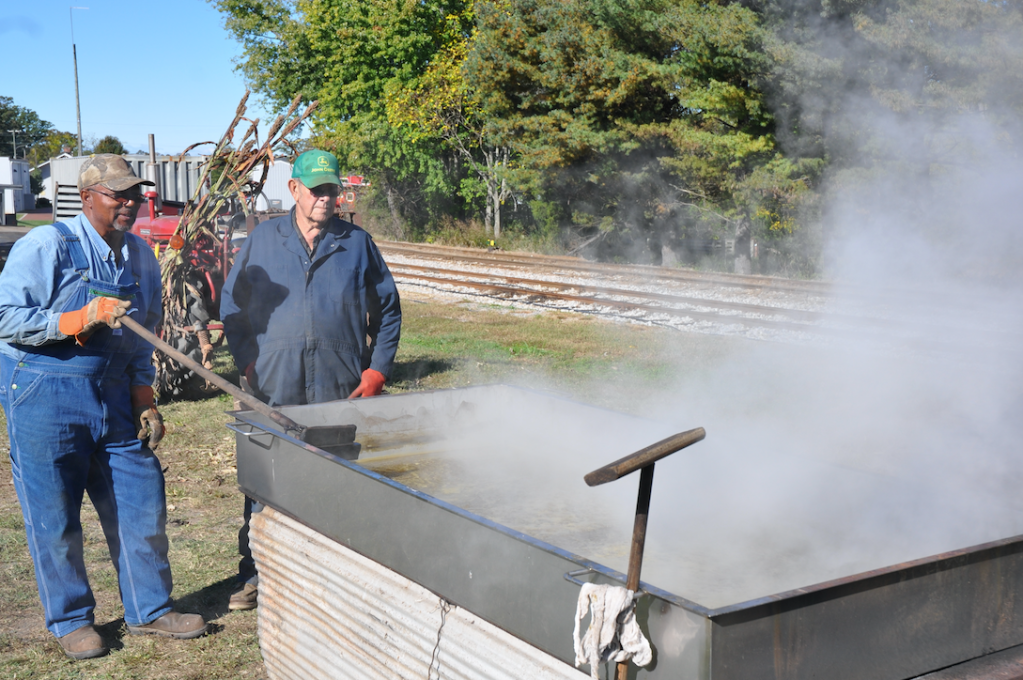Celebrating a forgotten way of life
Published 11:40 am Wednesday, November 23, 2016

- JORDAN MILES | HERALD Roy Ayers watches while Lester Morris, left, stirs the sorghum juice as it goes through the evaporation process.
Though it receives little fanfare, Robert “Bob” Bryant’s annual tradition of cooking down sorghum to make molasses serves to educate people on how to make the old-time product.
The delicate process requires experience, time and, most of all, patience.
Bryant, founder and chairman of the board of Buckingham Branch Railroad (BBRR), recently formed his team — Steve Powell, BBRR’s president, along with Roy Ayers and Lester Morris — to make the cook happen.
Though Bryant has been making molasses for about 14 years now, squeezing plants to cook up molasses dates back to the 1800s.
“Because, when I was a child, my parents did it,” Bryant said of his reasoning behind the annual cook. “That was the real motivation … getting back to the good ol’ days. I just thought it would be a fun thing to try to do and let our current generation learn about that process.”
Bryant has held the cook on his farm, in Alpha, at Sprouse’s Corner and at the railroad tracks in Dillwyn, where it was held a few weeks ago.
“You do it based on the weather. And it’s a process,” Bryant said.

JORDAN MILES | HERALD
Robert Bryant, founder and chairman of the board of Buckingham Branch Railroad, smiles as he holds a small vile of molasses, the finished product of the sorghum cook.
After his sorghum plants reach their maturity, the blades, or leaves, are stripped from the stalks while they stand in the field.
“Then, cut the seed head off … and then you cut the stalk and haul it from the feed to the mill.”
The mill, in this case, was a press hooked to his tractor’s PTO system at the site of the cook.
“And, in the old days, when I was a boy, they had a horse or a mule that would go round and around and turn it. That was the power when I was a boy,” Bryant said.
What results from milling the seed is a green-looking syrup juice. That’s what evaporated, or cooked, in a large heated pan.
“Pete Agee made us a (portable) firebox,” Bryant said of the heating source, which uses dry wood from Bryant’s farm, causing the evaporation process to take place.
“The extent of my help was in squeezing the juice out of the stalks and evaporating (cooking) the juice into the concentrated molasses,” Powell said. “This is the second year that I have helped all day doing this activity. Though this is hard work, it is really the end of the process. Bob, grows the stalks, has to strip all the leaves off, cuts the stalks and then transports them and all the equipment to Dillwyn.”
According to Powell, the tractor-powered mill “presses the stalks between several rollers that squeeze the sugary juice out of the stalk. We strain the juice as it is being produced through a screen to keep the big solid pieces out of the sorghum. Once we get a 5-gallon bucket full of the juice, we pour it through a cloth as we put it in the pan to start evaporating it.”
The pan where the evaporation takes place holds up to 80 gallons of juice. When cooked down, the 80 gallons will be reduced to around 10-15 gallons of molasses.
“The trick is when you take it off so, you have the right viscosity, the right thickness,” Bryant said. “That’s always a fun discussion. We usually go the committee route. Everybody agrees afterwhile.”
Powell agreed.
“You want the molasses to be thick when it cools,” he said, “but not too thick so it will not come out of the jar. Several methods are used to determine when it is ready, including dripping the hot sorghum into cool water and watching for it to congeal, observing the bubbles in the pan wanting them to be around the size of a quarter when it is ready, watching the molasses drip off a spoon to see how thick it is, and lots and lots of opinions from all the participants.”
“So you run it through a strainer when you take it off the evaporator,” Bryant said. “It normally goes into buckets. Then we process it.”
The result is a sweet-tasting thick molasses, good for cooking and many other uses. Bryant bottles the molasses up, giving it to others as a gift.
“My wife likes using it when she makes bread or muffins instead of using sugar,” Powell said.
Bringing the forgotten way of cooking and making molasses to life is a learning process for Bryant and his team. Though he was never formally taught, Bryant said he learned from doing it himself and watching his family.
“We’re still learning, in the process,” he laughed.





